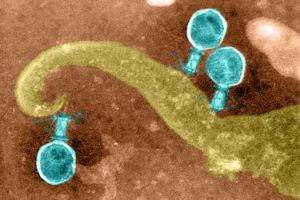When a stoned Carl Sagan used to do his TV bit and talk about billions and billions of galaxies, I turned my world inward, to the trillions and trillions of viruses.
 I tell daughter Sorenne, I don’t care which you focus on, but get one of them right.
I tell daughter Sorenne, I don’t care which you focus on, but get one of them right.
According to Jim Robbins of the New York Times, high in the Sierra Nevada mountains of Spain, an international team of researchers set out four buckets to gather a shower of viruses falling from the sky.
Scientists have surmised there is a stream of viruses circling the planet, above the planet’s weather systems but below the level of airline travel. Very little is known about this realm, and that’s why the number of deposited viruses stunned the team in Spain. Each day, they calculated, some 800 million viruses cascade onto every square meter of the planet.
Most of the globe-trotting viruses are swept into the air by sea spray, and lesser numbers arrive in dust storms.
“Unimpeded by friction with the surface of the Earth, you can travel great distances, and so intercontinental travel is quite easy” for viruses, said Curtis Suttle, a marine virologist at the University of British Columbia. “It wouldn’t be unusual to find things swept up in Africa being deposited in North America.”
The study by Dr. Suttle and his colleagues, published earlier this year in the International Society of Microbial Ecology Journal, was the first to count the number of viruses falling onto the planet. The research, though, is not designed to study influenza or other illnesses, but to get a better sense of the “virosphere,” the world of viruses on the planet.
Generally it’s assumed these viruses originate on the planet and are swept upward, but some researchers theorize that viruses actually may originate in the atmosphere. (There is a small group of researchers who believe viruses may even have come here from outer space, an idea known as panspermia.)
Whatever the case, viruses are the most abundant entities on the planet by far. While Dr. Suttle’s team found hundreds of millions of viruses in a square meter, they counted tens of millions of bacteria in the same space.
Mostly thought of as infectious agents, viruses are much more than that. It’s hard to overstate the central role that viruses play in the world: They’re essential to everything from our immune system to our gut microbiome, to the ecosystems on land and sea, to climate regulation and the evolution of all species. Viruses contain a vast diverse array of unknown genes — and spread them to other species.
Last year, three experts called for a new initiative to better understand viral ecology, especially as the planet changes. “Viruses modulate the function and evolution of all living things,” wrote Matthew B. Sullivan of Ohio State, Joshua Weitz of Georgia Tech, and Steven W. Wilhelm of the University of Tennessee. “But to what extent remains a mystery.”
We’re all hosts on a viral planet.
I didn’t understand this until fourth-year university, and it was only then I became interested in learning.
Until then, I was bored.
Researchers recently identified an ancient virus that inserted its DNA into the genomes of four-limbed animals that were human ancestors. That snippet of genetic code, called ARC, is part of the nervous system of modern humans and plays a role in human consciousness — nerve communication, memory formation and higher-order thinking. Between 40 percent and 80 percent of the human genome may be linked to ancient viral invasions.
Viruses and their prey are also big players in the world’s ecosystems. Much research now is aimed at factoring their processes into our understanding of how the planet works.
“If you could weigh all the living material in the oceans, 95 percent of it is stuff is you can’t see, and they are responsible for supplying half the oxygen on the planet,” Dr. Suttle said.
In laboratory experiments, he has filtered viruses out of seawater but left their prey, bacteria. When that happens, plankton in the water stop growing. That’s because when preying viruses infect and take out one species of microbe — they are very specific predators — they liberate nutrients in them, such as nitrogen, that feed other species of bacteria. In the same way, an elk killed by a wolf becomes food for ravens, coyotes and other species. As plankton grow, they take in carbon dioxide and create oxygen.
One study estimated that viruses in the ocean cause a trillion trillion infections every second, destroying some 20 percent of all bacterial cells in the sea daily.
Viruses help keep ecosystems in balance by changing the composition of microbial communities. As toxic algae blooms spread in the ocean, for example, they are brought to heel by a virus that attacks the algae and causes it to explode and die, ending the outbreak in as little as a day.
While some viruses and other organisms have evolved together and have achieved a kind of balance, an invasive virus can cause rapid, widespread changes and even lead to extinction.
